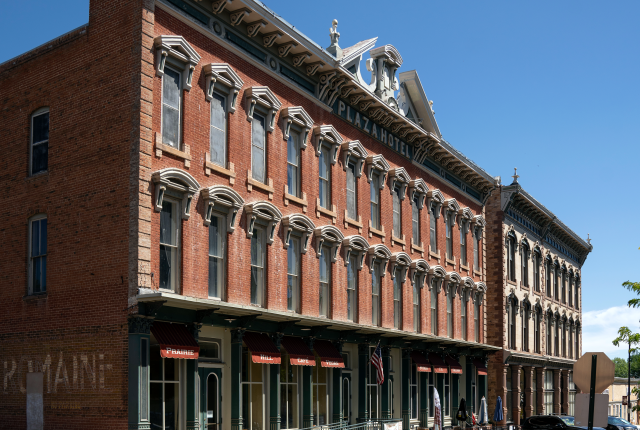WHEN LAWRENCE QUINTANA WAS A SENIOR at West Las Vegas High School, the class of 1977 was allowed to roam the nearby Las Vegas Plaza during lunch. But a sandwich—or even a bit of window shopping—could be hard to come by.
“This place was mostly vacant,” Quintana remembers. More than half of the stately Victorian-era buildings surrounding the 1835 town square sat empty and boarded up. The community’s fear of losing what may be the country’s largest concentration of historic buildings per capita sparked the Citizens’ Committee for Historic Preservation (CCHP), which was founded the year Quintana graduated. He now serves as the CCHP’s president.
In the nonprofit’s Bridge Street offices, black-and-white photos of nearby properties show none of the 1970s slump he remembers. Instead, the images document the extraordinary architecture of the Old West town, which was established seven decades before the Sin City of the same name sprouted in Nevada. More than 900 buildings on the National Register of Historic Places tell the story of this one-of-a-kind settlement. Fueled first by the Santa Fe Trail and then the railroad, plus a bustling wool trade and sheep and cattle industries, the original Las Vegas had become the most populous and prosperous place in the New Mexico Territory by the turn of the century. Its magnificent buildings still reflect the city’s fin de siècle reign.
From the silent Westerns of Tom Mix to Easy Rider, No Country for Old Men, Red Dawn, and the TV series Longmire, Las Vegas has served as a stand-in for many real and fictional American towns. It’s easy to see why. Edifices that seem exported from 19th-century St. Louis, Chicago, or New York dominate the landscape. Their curved parapets and grand gables awe visitors who assume the ubiquity of adobe in New Mexico. Whether Victorian, Queen Anne, Italianate, Prairie, Beaux Arts, or any of at least 30 other architectural styles, these once-fashionable buildings rose with the 1879 arrival of the Atchison, Topeka & Santa Fe Railway Company. They proliferated during America’s Gilded Age, when stones from local quarries were ferried into town to build stores, hotels, churches, and houses that would telegraph the image of a grand new Western empire.
Less than a century later, after fortunes declined along with the railroad, the local economy, and the population, the CCHP and the state Historic Preservation Division began working to turn around the fate of these structures. Many of them represent the best-preserved architectural examples of their kind.
These days, there’s a new boom in the old town. “So many great landmarks have been saved in the last 40 years,” says historic preservationist Elmo Baca over lunch at Stella’s Cafe. “Now what we’re seeing is more houses getting saved. If you look at the real estate transactions during Covid, it would surprise you how many people moved here, and how many new businesses were created.”
Where we’re eating is a prime example. Last summer, Jan and Frank Beurskens reopened the 1884 building that housed Estella’s Cafe, which saw four generations of owners before the structure fell into disrepair and went on the market. After a renovation that began in 2019, the couple renamed their eatery Stella’s as a tribute to both its history and its new incarnation.
Preservationist Allan Affeldt, who owns both the Castañeda Hotel and the Plaza Hotel in Las Vegas, sits across the table from Baca. Although Affeldt’s other historic properties include crown jewels like La Posada Hotel, in Winslow, Arizona, and the Legal Tender, in Lamy, he says the character of Las Vegas endlessly fascinates him. “This is the architectural treasure trove of the Southwest, because it’s authentic,” he says. “Santa Fe today is not the way it was built. Las Vegas is.”
Most of us dream of encountering a lost civilization—entering crumbling halls, exploring the flotsam and jetsam of abandoned family homes. But Las Vegas is far from lost. An architecture-focused stroll yields a wealth of enduring design and craftsmanship. From the groundbreaking enterprises of immigrant merchants to the bright ideas of local businesspeople, a robber baron, and more than one visionary filmmaker, these beautiful buildings tell tales.
Read more: The Las Vegas Plaza is like an intro course to the town's past.




